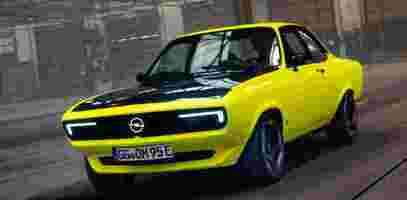All I want for Christmas is Opel’s electric restomod
This year I’v decided I’m going to ask explicitly what I want for Christmas. And all I want is the Opel Manta GSe ElektroMOD. Opel unveiled this beauty in May and since then I just can’t stop thinking about it.

I mean, just look at it…


Yes, I’m sucker for reimagined classic vehicles , and I have to say that Opel has done an amazing job here.
The traditional proportions of the new EV instantly recall the Manta A , the 1970s classic coupe, only now it’s equipped with an electric heart. And coming with a 108 kW electric motor and a 147hp, it’s more powerful than ever.
Much like the original, the renewed Manta maintains the rear-wheel-drive layout and even keeps the four-speed manual gearbox — how cool is that?
And still, we get some brand new features that give the vehicle an ultra-modern feeling.
First up, the interior has been redefined. We now have a 2-inch and a 10-inch screen for the instrument panel and infotainment system. Plus, a Marshall Bluetooth box to handle the driving tunes.
And here’s my absolute favorite: t he grille of the original Manta is now a digital display, called “Pixel-Vizor.” This way, the car can communicate with the world and “speak” for itself.
What is it saying, you’re wondering? “ I’m on a zero e-emission,” “I’m an ElektroMOD,” “My German heart has been ELEKTRified!”
Pair all these with its neon yellow color and… I’m sold.
Unfortunately, Opel isn’t planning to sell the electric Manta — so I’m bringing the big guns and addressing the only person with the ability to make the impossible come true.
Dear Santa, could you please ask your elves to create the ElektroMOD for me? I’ve been really good this year. You can show them the video below to know exactly what to make.
NYC folks just got another reason to buy an EV: curbside chargers are coming
New York City plans to expand its currently limited EV charging infrastructure with new curbside chargers that will be introduced in October.

Well, that does make sense, given that NYC’s five boroughs are so overcrowded that drivers mostly park their cars at the curb. The city’s Department of Transport (DOT) believes that by enabling EV drivers to charge their cars when they – I’m sure not without effort – find a curbside parking spot, it can further encourage the adoption of electric vehicles.
The project is called “PlugNYC” and aims to install 120 Level 2 charging ports at curbside locations across the five boroughs. Among them, 100 will be for public use, and the remaining 20 will serve the city’s fleet of electric vehicles.
EV owners will pay for their car’s juice on an hourly basis by smartphone, tap card, or on the program website. According to The Wall Street Journal , the new city chargers will cost $2.50 per hour during the day and $1 per hour overnight.
PlugNYC is funded by a grant from the New York State Public Service Commission, and will run in partnership with the American energy company Consolidated Edison.
The two partners will select curbside locations based on projected demand for charging, geographic diversity, and input from local elected officials and community stakeholders.
With the current number of public charging stations in NYC below 1,500, the curbside ports can only be a good thing.
But anyway, you’ll need to curb your enthusiasm a little: t he chargers will be in place for four years as part of a demonstration project, which will include an evaluation period. So who knows what will happen next.
For more information, you can check out NYC DOT’s website .
Do EVs excite your electrons? Do ebikes get your wheels spinning? Do self-driving cars get you all charged up?
Then you need the weekly SHIFT newsletter in your life. Click here to sign up .
Are classic cars still ‘classic’ if converted to EVs? YES, yes they are.
If there’s one topic that’s likely to elicit strong feelings among vehicle aficionados, it’s the conversion of a classic car into an electric vehicle.

During the past few years, there’s been a flurry of electrified classic vehicle unveilings from newly launched independent firms, such as Lunaz , Electric Classic Cars , and Electrogenic , as well as an array of manufacturer-backed efforts including Jaguar’s E-Type Zero , Volkswagen’s e-Kafer , and the Renault 4 e-Plein Air .
Yet not everyone’s happy about it and many among the antique car enthusiasts find the conversion to electricity, well, a sacrilege.
For some the answer’s a big NO.
The altering of classic cars was first renounced in 2019 by the F é d é ration Internationale des V é hicules Anciens (FIVA) — translated as the “International Federation of Ancient Vehicles.”
According to the body’s statement :
Similar is the view of Wayne Scott, director of the Federation of British Historic Vehicle Clubs, who said to the BBC :
Fears over altering a classic car’s essence and missing out on the original experience are also shared by members of the Antique Automobile Club of America (AACA):
Well, to a certain extent they are. Antique cars are testaments to past human engineering ingenuity, and the combustion engine is an essential part of that.
As with any historic artifact, to replace any part of its core elements, means that you reduce its authenticity. But do you also diminish its historical value?
Let’s take another example from a more illuminating field on the matter: architecture.
Below you can see a photo of the buildings in Amsterdam’s city center.


These buildings have national heritage status as historic artifacts of Dutch culture. It’s illegal to make changes to their exterior design and they can’t be demolished.
But to be livable and functional in the modern era, their interior has undergone various restorations.
Does this reduce their historic value or character? No, it certainly doesn’t.
The same principle can be applied to classic cars. As much as the buildings of Amsterdam, antique vehicles need to be reinvented in order to fit into the future, which — let’s face it — is electric.
We can keep the classics in a museum and admire them for their heavy heritage, but this way we simply fossilize them as a part of our past, as an artifact that has no relevance in the word we live in.
Instead, the conversion of such vehicles into EVs can actually bring them from the past into everyday use, actively preserving their memory rather than burying it.
Yes, we may miss out on the experience of the engine’s roaring sounds and feel… but this argument has nothing to do with classic cars.
It’s the main argument in favor of any petrol or diesel vehicle, which mostly indicates our difficulty to let go of the familiar and embrace a big, unfamiliar change.
Do EVs excite your electrons? Do ebikes get your wheels spinning? Do self-driving cars get you all charged up?
Then you need the weekly SHIFT newsletter in your life. Click here to sign up .